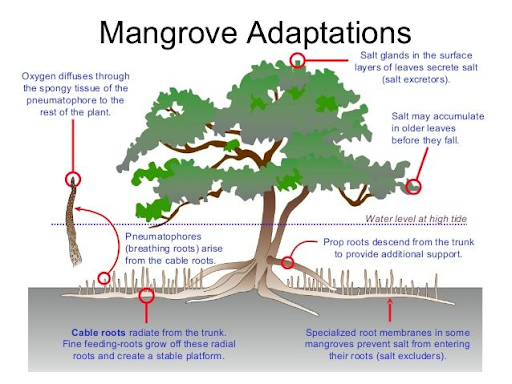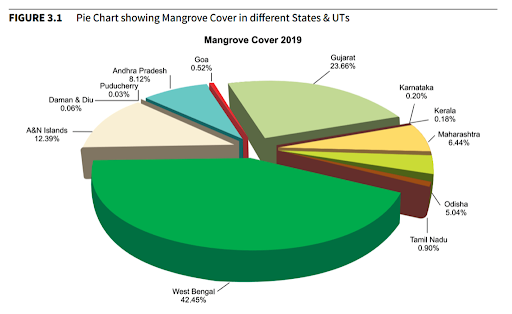Mangroves
What is Mangrove?
- Mangrove swamps are coastal wetlands found in tropical and subtropical regions.
- Mangroves belong primarily to the families Rhizophoraceae, Acanthaceae, Lythraceae, Combretaceae, and Arecaceae.
- They are characterized by halophytic (salt loving) trees, shrubs and other plants growing in brackish to saline tidal waters.
- These wetlands are often found in estuaries, where fresh water meets salt water.
Adaptation mechanisms
- Many mangroves characteristically have prop roots descending from the trunk and branches, providing a stable support system in the submerged conditions.
- Many mangrove species survive by filtering out as much as 90 percent of the salt found in seawater as it enters their roots. Some species excrete salt through glands in their leaves.
- Some mangroves have pencil-like roots called pneumatophores that grow out from the water surface. Pneumatophores facilitate the aeration necessary for root respiration in mangroves.
- Mangroves, like desert plants, store fresh water in thick succulent leaves. A waxy coating on the leaves seals in water and minimises evaporation.
- Mangroves are viviparous, their seeds germinate while still attached to the parent tree. Once germinated, the seedling grows into a propagule. The mature propagule then drops into the water and gets transported to a different spot, eventually taking root in a solid ground.

Significance of mangroves
- A wide diversity of plants and animals are found in mangrove swamps. Since these estuarine swamps are constantly replenished with nutrients transported by fresh water runoff from the land and flushed by the ebb and flow of the tides, they support a bursting population of bacteria and other decomposers and filter feeders.
- Because mangroves create dense foliage and close proximity of trees, they protect shorelines from damaging winds and waves. A series of studies in the early 2000s discovered that mangroves with an average height of 6-10 metres could shorten a cyclone’s waves by 60%.
- Their protective role has been widely recognized especially after the devastating Tsunami of 2004.
- Mangrove forests stabilize the coastline, and help prevent erosion by stabilising sediments with their tangled root systems.
- Mangroves also have a big impact on climate. Mangroves are powerhouses when it comes to carbon storage. Studies indicate that mangroves can sequester greater amounts of carbon than other trees in the peat soil beneath. They store this carbon for thousands of years.
- The intricate root system of mangroves also makes these forests attractive to fish and other organisms seeking food and shelter from predators.
- Many people living in and around mangroves depend on them for their livelihood. The trees are a source of wood for construction and fuel. The ecosystem provides local fishermen with a rich supply of fish, crabs and shellfish. The ecosystem also supports tourism.
Where are mangrove ecosystems found?
- Mangroves can be found in more than 120 countries and territories in the tropical and subtropical regions of the world. The largest extent of mangroves is found in Asia (42%) followed by Africa (20%), North and Central America (15%), Oceania (12%) and South America (11%).
- In India, the deltas of the Ganges, Mahanadi, Krishna, Godavari, and the Cauvery rivers contain mangrove forests.
- The Sundarbans in West Bengal is the largest mangrove region in the world and a UNESCO World Heritage Site. It spans from the Hooghly River in West Bengal to the Baleswar River in Bangladesh.
- Gulf of Kachchh harbours one of the major mangrove formations of India. Pichavaram in Tamil Nadu has a vast expanse of water covered with mangrove forests. It is home to many aquatic bird species.
- The backwaters in Kerala also have a high density of mangrove forest.

What are the threats to mangroves?
- Scientists estimate that at least one third of all mangrove forests has been lost during the last few decades. Coastal development, including construction of shrimp farms, hotels, and other structures, is the primary threat to mangroves.
- Mangrove forests are cleared to make room for agricultural land and human settlements.
- Mangrove trees are used for firewood, construction wood, charcoal production, and animal fodder. In some parts of the world, there has been overharvesting which is no longer sustainable.
- Overfishing, pollution, and rising sea levels are the other threats to mangrove forests and their ecosystem.
Why in the news?
- The Government has taken steps to protect, sustain, conserve and augment forests in the country through promotional as well as regulatory measures.
- The promotional measures are being implemented through a Central Sector Scheme under National Coastal Mission Programme on ‘Conservation and Management of Mangroves and Coral Reefs’.
- Under this programme, annual Management Action Plan (MAP) for conservation and management of mangroves are formulated and implemented in all the coastal States and Union Territories.
- Regulatory measures are implemented through Coastal Regulation Zone (CRZ) Notification (2019) under the Environment (Protection) Act, 1986; the Wild Life (Protection) Act, 1972; the Indian Forest Act, 1927; the Biological Diversity Act, 2002; and rules under these acts as amended from time to time.
- As per information provided by the World Wide Fund for Nature, (WWF), India, the WWF India has enjoined citizens in nine states, which include Maharashtra, Goa, Gujarat, Andhra Pradesh, Tamil Nadu, Kerala, Odisha, West Bengal and Karnataka on mangrove conservation through the Magical Mangroves campaign.
- The Ministry of Environment, Forest and Climate Change piloted an Integrated Coastal Zone management Project in Coastal stretches of 3 states namely Gujarat, Odisha and West Bengal, with the objective of Conservation and Protection of Coastal resources which included plantation of mangroves as one of the major activities.
- The Forest Survey of India (FSI) assessed Mangrove Cover of the country in three density classes i.e. very Dense, Moderately Dense and Open Mangrove Cover on biennial basis and publishes the findings in the India State of Forest Report (ISFR).
- As per the ISFR 2021, the mangrove cover in the country has increased by 17 sq. km. in year 2021 as compared to the mangrove cover assessed in year 2019.
Reference:
Subscribe
Login
0 Comments
